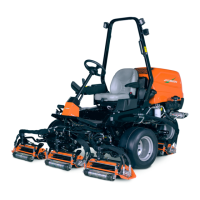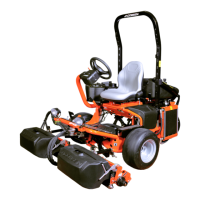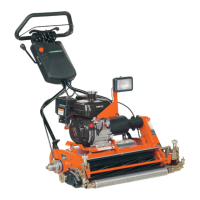HYDROSTATIC POWER TRAIN
673831-Rev A 5-57
5
f. Using the press and inner roller bearing—inner
race installation tool, apply 12,364 lb (55,000 N)
force (F) to bearing (6) for five seconds, then
reduce force to 618 lb (2750 N).
g. Measure and record the torque (Cm) necessary
to rotate bearing support (4).
h. Determine the bearing support rotation torque:
C = Cm x (R+L)/L
i. If bearing support rotation torque is not within
8.85 ± 30% lb-ft (12 ± 30% N·m), remove snap
ring (8) and replace shim spacer (7) with a
thinner shim spacer (to decrease torque) or
thicker shim spacer (to increase torque).
j. Repeat steps a through i as necessary to meet
specification.
k. Remove screw (41).
19. Lubricate new O-ring (9) with Mobilux EP2 grease, or
equivalent NLGI Grade EP2 grease, and install
O-ring in bearing support (4).
20. Lubricate new O-ring (11) with Mobilux EP2 grease,
or equivalent NLGI Grade EP2 grease, and install
O-ring in valving cover (18).
There are three different sizes of seal rings and backup
rings. Install the smallest seal ring to the deepest groove
first.
21. Install new seal rings (15–17) in valving cover (18),
smallest first.
22. Install new backup rings (42–44) in valving cover
(18), smallest first.
Figure 5-61
23. Using grease, insert spring (45) into hole (47) of
valving cover (18).
Make sure locating pin in valving (14) aligns with timing
notch in valving cover (18) when installing valving in
valving cover.
24. Install valving (14) in valving cover (18).
25. Install rotational group (12).
Figure 5-62
26. Using alignment mark (48) previously scribed on the
wheel motor, install cam ring (10) on bearing support
(4).
Make sure alignment of locating pin in valving (14) and
timing notch in valving cover (18) is maintained when
installing valving cover.
27. Install valving cover (18) in line with the marks made
during disassembly.
28. Center the cam by installing two screws (41) 180°
apart.
29. Install screws (41) and tighten to 61 ± 10% lb-ft (83 ±
10% N·m) using an alternating pattern.
Brake Assembly
When removing retaining compound residue from
valving cover (18), do not scratch the surface. The
original surface finish must be maintained.
30. Ensure any dried retaining compound on the bushing
mating surfaces of valving cover (18) is removed.
Scrape off all retaining compound residue with a
blade or fine (1200 grit) sandpaper.
31. Clean/degrease a new bushing (22) and the bushing
mating surfaces of valving cover (18) with isopropyl
alcohol.
4
48
10
18

